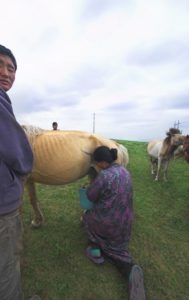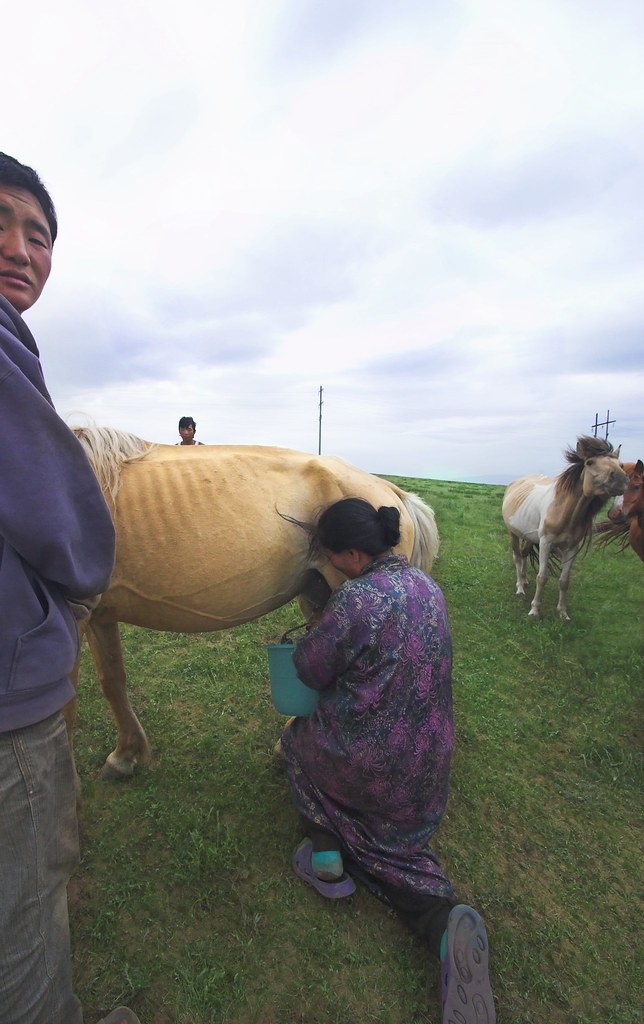Airag or Kumis is one of the traditional drinks that’s popular in Mongolia and Central Asia. Basically it’s fermented mare’s milk that nomads learned how to make long ago.
Besides for warfare and transportation in Mongolian history, horses have been a vital source of food not just for Mongolians, but other Central Asian countries as well.
Origins and Cultural Significance of Airag / Kumis
Airag, also known as “kumis” in some Central Asian regions, is a traditional fermented dairy beverage with a rich history and deep cultural significance. Its origins can be traced back to the nomadic herding communities of Mongolia and the surrounding regions, where it has been consumed for centuries.
The practice of fermenting horse milk to produce Airag dates back to the ancient pastoralist societies of Central Asia. Nomadic herders, who relied on horses for transportation, milked their mares as a valuable source of nutrition. The milk, known for its high sugar content, was fermented to create a tangy and slightly alcoholic beverage, which offered both sustenance and refreshment.
Airag holds a revered place in Mongolian culture, serving as a symbol of hospitality and celebration. It is often shared during special occasions, such as festivals, weddings, and important gatherings, bringing people together and strengthening social bonds. In addition to its role as a beverage, Airag is deeply intertwined with the traditions, customs, and folklore of the Mongolian people.
The cultural significance of Airag extends beyond Mongolia. In neighboring Central Asian countries like Kazakhstan, Kyrgyzstan, and Xinjiang in China, where the beverage is known as Kumis, it holds a similar status. Kumis is an integral part of the nomadic heritage and is still produced and consumed by communities living in these regions.
For nomadic herders, Airag represented more than just a beverage. It symbolized their close relationship with horses, their reliance on the land, and their connection to nature. The preparation and consumption of Airag were and still are seen as a way to honor and preserve their traditional way of life.
How Is Airag Made?

Airag, the traditional Mongolian fermented dairy beverage, is made through a meticulous process that involves fermenting raw horse milk. Here is a step-by-step explanation of how Airag is made:
- Milking: The process begins with milking mares, typically during the spring and early summer when the horses graze on nutrient-rich pastures. The mares are milked by hand or using traditional methods to collect the raw horse milk.
- Milk filtration: The collected horse milk is then filtered to remove any impurities or debris, ensuring a clean base for the fermentation process.
- Fermentation container: The filtered milk is transferred to a large, specially designed container known as a “khokhuur.” The khokhuur is typically made from animal hide, and its shape and size facilitate the fermentation process.
- Starter culture: A small amount of previously fermented Airag, known as “jigee,” is added to the fresh horse milk. The jigee serves as a starter culture, introducing beneficial bacteria and yeast to initiate the fermentation.
- Fermentation: The khokhuur is tightly sealed to create an airtight environment, allowing the milk to ferment naturally. The container is usually placed outdoors or in a cool area to maintain optimal fermentation conditions.
- Fermentation period: The milk undergoes fermentation for several hours to a few days, depending on the desired taste and strength of the Airag. During fermentation, lactic acid bacteria and yeast naturally present in the environment metabolize the lactose in the milk, converting it into lactic acid and alcohol.
- Stirring: Throughout the fermentation process, the Airag is periodically stirred using a wooden stick or paddle called a “bunkhur.” This promotes even distribution of the bacteria and yeast, as well as aeration, enhancing the fermentation process.
- Aging: After the desired fermentation period, the Airag is left to age for a few more days to develop its distinctive flavors. The aging process allows the flavors to mature and the alcohol content to increase slightly.
- Straining and storage: Once the fermentation and aging are complete, the Airag is strained to remove any remaining solids or sediments. It is then stored in a cool place, often in traditional leather containers called “khurjun,” until it is ready to be consumed.

It’s important to note that the process may vary slightly depending on regional preferences and individual traditions. However, the fundamental steps of milking, filtration, fermentation, stirring, aging, and straining remain consistent in the production of Airag.
The best experience for drinking Airag is with a traditional wooden spoon, which is used to pour the milk into a big porcelain cup. For traditional festivals, sometimes the big cup is passed around the table so that everyone can share and enjoy the drink.
Health Benefits of Airag

Mare’s milk is packed with nutrients and minerals. Sometimes people even drink the raw milk, which is called Saam.
It cleans your digestive tracks and provides good bacteria.
If you drink to much though, you might have to use the toilet, so drink within reasonable amount if you want to avoid going to the bathroom frequently.
While scientific studies specifically focusing on Airag are limited, many of its benefits can be attributed to its probiotic content, nutritional profile, and bioactive compounds. Here are some potential health benefits associated with Airag:
- Probiotics: Airag contains a diverse range of beneficial bacteria and yeast strains due to the natural fermentation process. These probiotics can help support a healthy gut microbiome, which plays a crucial role in digestion, nutrient absorption, and immune function.
- Improved Digestion: The probiotics present in Airag can assist in improving digestion by aiding the breakdown and absorption of nutrients. They may also help alleviate symptoms of gastrointestinal disorders, such as bloating, gas, and constipation.
- Enhanced Nutritional Value: Fermentation increases the bioavailability of nutrients in Airag, making them more easily absorbed by the body. It is a source of vitamins, minerals, proteins, and enzymes, including B vitamins, calcium, potassium, and lactic acid.
- Potential Immune Support: The probiotics found in Airag have been associated with immune-enhancing effects. They may stimulate the production of immune cells, enhance the body’s natural defense mechanisms, and support overall immune function.
- Potential Anti-inflammatory Effects: Some studies suggest that fermented dairy products, including Airag, may possess anti-inflammatory properties. These effects could potentially help in managing inflammatory conditions, such as arthritis and certain gastrointestinal disorders.
- Lactose Digestion: The fermentation process of Airag partially breaks down lactose, making it potentially more tolerable for individuals with lactose intolerance. The beneficial bacteria in Airag produce lactase, the enzyme responsible for lactose digestion, which can aid in lactose assimilation.
- Antioxidant Activity: Airag contains various bioactive compounds, including antioxidants. These compounds help neutralize harmful free radicals in the body, thereby reducing oxidative stress and potential damage to cells.
It’s important to note that individual responses to Airag may vary, and individuals with specific health conditions or dietary restrictions should consult their healthcare provider before incorporating Airag into their diet. Additionally, commercial Airag products may have varying compositions and fermentation durations, which can influence the concentration of beneficial components and potential health benefits.
Airag / Kumis in Modern Day Culture

In recent years, airag has gained attention from tourists visiting Mongolia. The unique taste and cultural experience of drinking airag have become an attraction for travelers seeking authentic encounters with Mongolian traditions. This interest in airag has led to the establishment of airag-producing households, creating new economic opportunities for nomadic herders and their communities.
While airag holds a special place in Mongolian culture, it also faces challenges in the modern era. The nomadic lifestyle, which was once widespread, has declined, resulting in a reduced number of herders producing airag. Additionally, the preservation of traditional production methods and the availability of mare’s milk can be limited due to changing demographics and urbanization.
Frequently Asked Questions
What is airag or kumis?
Airag, also known as kumis, is a traditional fermented beverage made from mare’s milk. It is a staple in Mongolian culture and has been consumed for centuries.
What does airag / kumis taste like?
Airag has a distinctive taste that can be described as slightly sour and effervescent. The flavor is often compared to that of yogurt or sour cream, with a unique tanginess resulting from the fermentation process.
Is airag alcoholic?
Yes, airag is mildly alcoholic due to the fermentation process. The alcohol content typically ranges from 2% to 3%. However, it is important to note that the alcohol concentration in airag is relatively low compared to other alcoholic beverages.
Can you drink airag if you are lactose intolerant?
Since airag is fermented, it contains lower levels of lactose compared to fresh milk. Some individuals with lactose intolerance may be able to tolerate airag in small amounts, but it’s advisable to exercise caution and monitor your body’s response.
Where can you find airag?
Traditionally, airag is produced by nomadic herding communities in Mongolia. However, it can also be found in some specialized shops, markets, or restaurants in Mongolia’s cities and towns. Additionally, airag has gained popularity as a tourist attraction, and certain tour operators may offer opportunities to experience airag production and tasting.
Can airag be stored?
Airag is a perishable product and is best consumed fresh. It continues to ferment and develop flavor over time, so storing it for an extended period is not recommended. If refrigerated, it may keep for a few days, but the taste and quality may change.

